As a global company, PILLER Blowers & Compressors GmbH faces a special challenge: How do you succeed in planning and executing worldwide service assignments quickly and efficiently? The answer from the leading manufacturer of high-performance blowers is SAP Field Service Management (FSM).
This is how efficient scheduling of technicians work
FSM project with five phases
Recently, PILLER started to implement the FSM solution from SAP in a project with a total of five phases. The first phase - the central scheduling of service technicians in the planning board - has now been successfully completed. Phase 2 deals with mobile field service: The service technicians are able to call up important data such as checklists and relevant information on customers and machines via app and to record working hours or expenses. While the third phase aims at billing and invoicing with an integration in SAP S/4HANA, phase 4 deals with setting up a self-service portal to offer customers helpful features – from ticket creation via QR code scan to the arrangement of service appointments with intelligent chatbots or status retrieval for each request. Finally, the fifth phase will focus on setting up reporting options on the various steps and tools (C4C, FSM, S/4HANA) as well as the presentation of KPIs and management dashboards.

A lot of potential for the optimization of dispatching
Previously, PILLER used Microsoft Excel for scheduling the service technicians, which had certain limitations in terms of a smooth, efficient dispatching. The responsible service dispatchers did not work with real-time data and could not take into account daily developments and changes. In addition, it was not possible for several dispatchers to process resource planning at the same time. This resulted in different versions of a planning file being sent back and forth by e-mail. Instead of being able to rely on a “single source of truth”, there was always the risk of working with data that was no longer up to date.
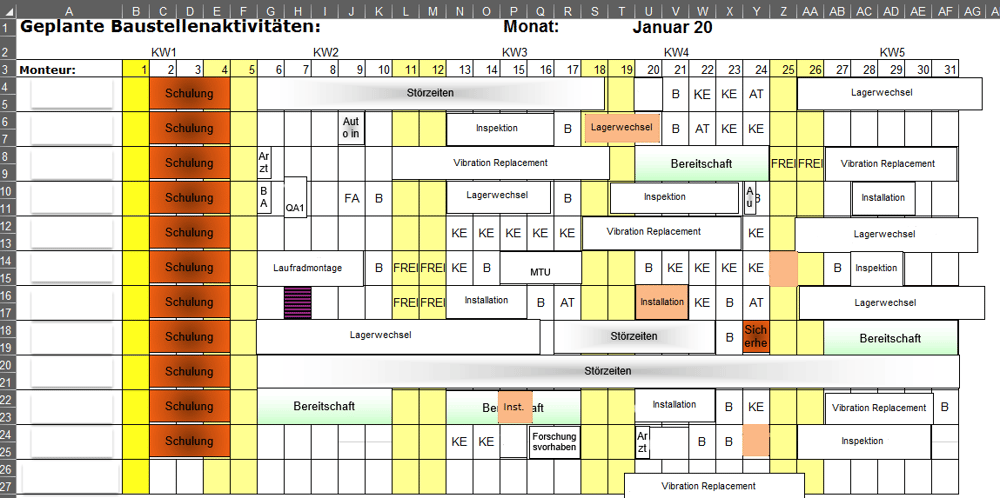
Previous scheduling with Excel was costly and inflexible.
Another shortcoming was that the various service categories could not be clearly depicted. For example, in order to include the technicians’ vacation days in the planning, the service employees had to access different systems. Media breaks were the order of the day because PILLER uses SAP Cloud for Customer (C4C) for ticket processing in addition to Excel. Nor was it possible to convert the time zones with Excel – a functionality that is particularly important for PILLER as a globally active company with an export share of 85% of its machines. In summary, it was an enormous effort for the service staff to include all relevant information and to adapt and update the Excel lists.
The goals with SAP Field Service Management
Against this background PILLER has linked a number of objectives to the introduction of SAP Field Service Management. These included the creation of integrated processes and systems for optimized information flow, automation of tasks and improvement of data quality. Automated processes were to shorten throughput times and increase service efficiency. PILLER also expected the FSM solution to unify time, expense and spare parts recording in a single tool.
At a glance: KPIs prove the success
-
Reduction of the average processing time of service tickets by 20%
-
Decrease of 50% in the average time required to collect machine data
-
Increase of 10% in sales in after-sales
The planning module of SAP Field Service Management offers visually appealing interfaces with convenient drag & drop functionality. Parameters such as status, category or offer status can be color-coded. Technicians, assignments and customers are clearly visualized on a map. When selecting service technicians, the module takes into account the qualifications required for an on-site assignment. In addition, it is able to map different planning scenarios, for example for individual regions or teams, and to include different time zones. Thanks to the seamless integration into the SAP Service Cloud (C4C), the system can transfer tickets directly to the FSM solution. The integration of master data is possible bidirectionally.
From the ticket to the service assignment
The SAP Service Cloud, consisting of C4C and SAP Field Service Management, maps the entire dispatching process – from generating a ticket to notifying the technician about the upcoming deployment. At first the customer reports his request by e-mail or by filling out a form on the website, which creates a service ticket in the SAP Service Cloud. This can also be done by an IoT device reporting an error or by manually opening a ticket.

The scheduling process from opening the ticket to notifying the technician.
The subsequent interaction of PILLER support with the customer determines the exact problem and the best way to solve it. If a technician is required, the SAP Service Cloud transfers the ticket to the FSM solution. There, the agent schedules the technician’s on-site visit to the customer and sends the relevant information to the technician via e-mail from the system.
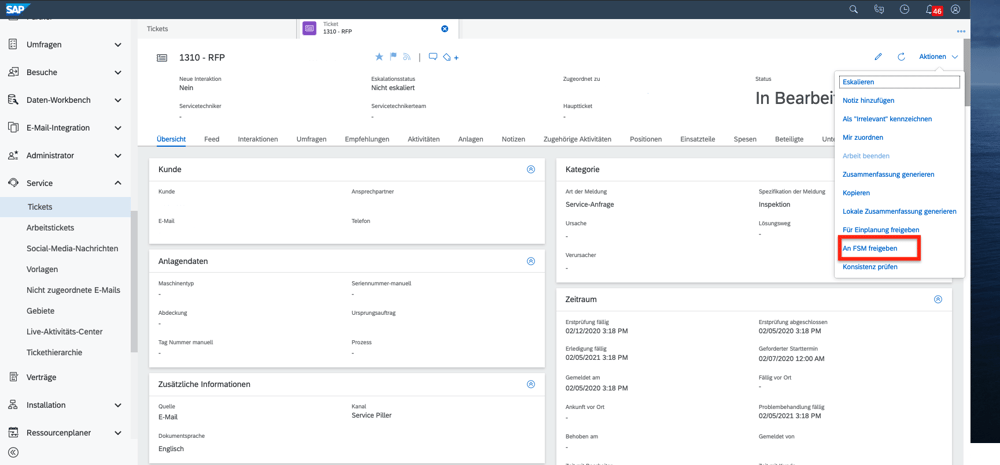
If necessary, the customer request is transferred to the FSM solution in the SAP Service Cloud.
Scheduling with numerous advantages
This process makes resource planning particularly efficient. All participants work in the same system, which prevents media breaks and double data management. The display with different colors and maps ensures clarity. The relevant information can be captured at a glance, and questions can be answered immediately.
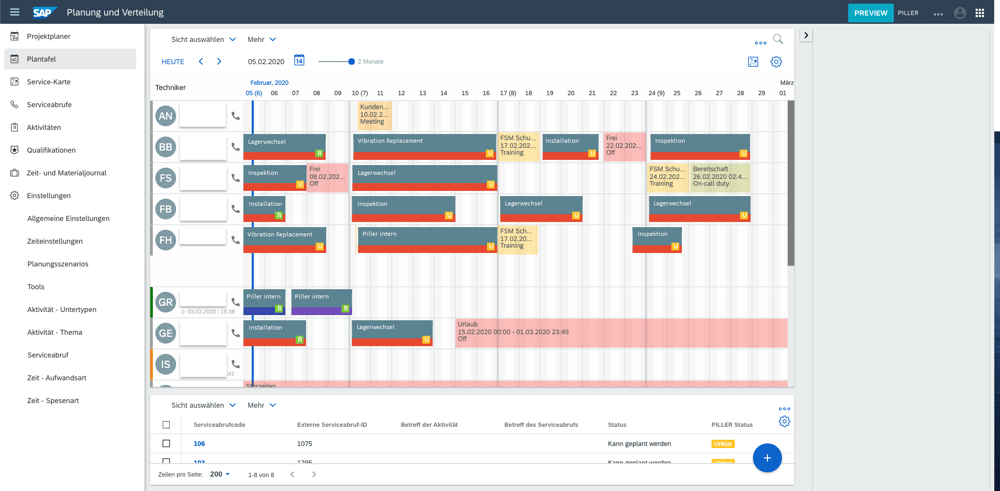
In the planning board, the assignments of the technicians are clearly displayed.
SAP Field Service Management reduces paperwork and lowers service costs. The processes involved in ticket handling and scheduling technicians can be viewed at any time, regardless of location, and are also transparent to outsiders. Service deployments and intervals can be better monitored and planned more precisely. For the customer, on the other hand, the smooth processing of his request and rapid problem solving ensure high satisfaction and generate loyalty to the manufacturer.
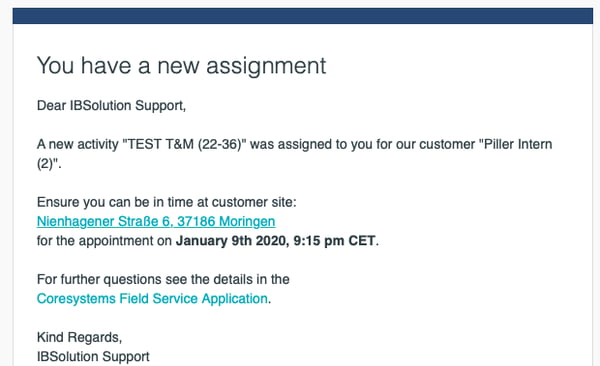
The technician receives notification of a new assignment by e-mail.
Next step: mobile app
Currently, two service dispatchers use the system to plan the assignments of 13 technicians with global coverage. Following the successful start of the FSM project, the second phase is already underway: A mobile app is to provide technicians on site with all relevant information on the respective customer – contact person, address, machines, concerns – via a mobile app. Various checklists, such as inspection protocols, can also be called up using the app. Conversely, the technicians will be able to report information on mileage, working and travel times, and import service reports including the customer’s digital signature into the system, thus creating a central machine file. In order to further improve dispatching, a functionality is also planned that automatically suggests technicians for assignments depending on location and qualification.
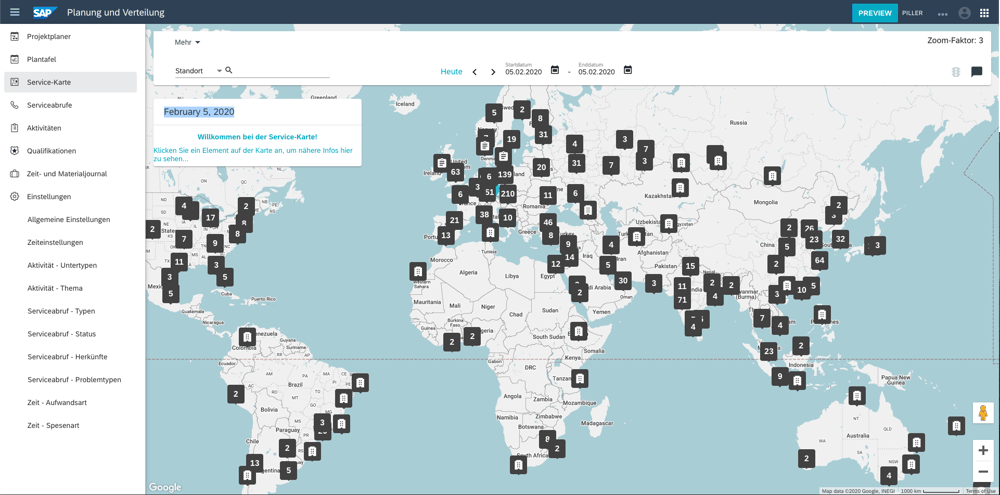
Service around the globe: PILLER technicians are on duty all over the world.
![IBacademy_Logo_blau[496] IBacademy_Logo_blau[496]](https://www.ibsolution.com/hs-fs/hubfs/IBacademy_Logo_blau%5B496%5D.jpg?width=200&name=IBacademy_Logo_blau%5B496%5D.jpg)




